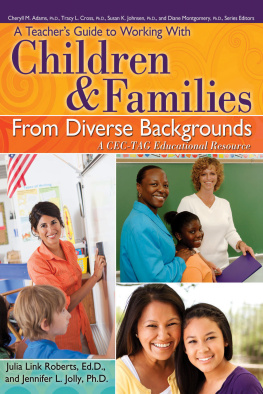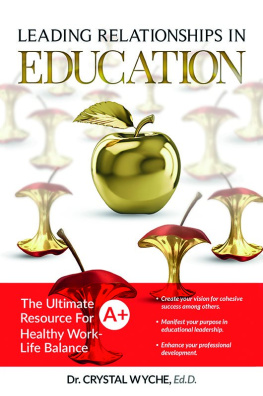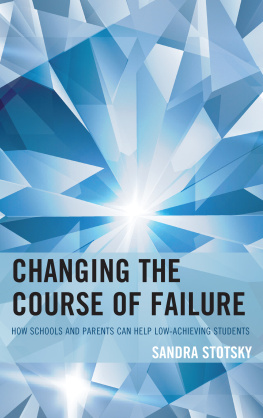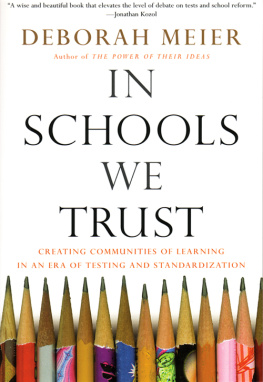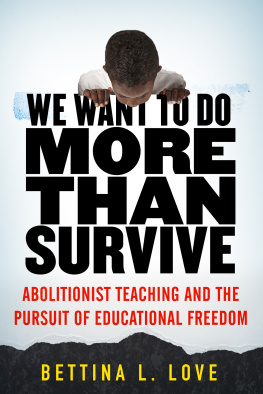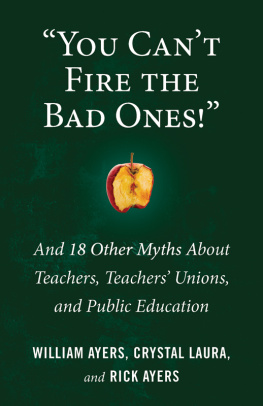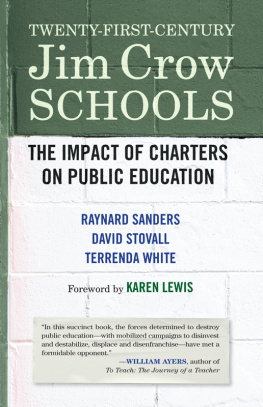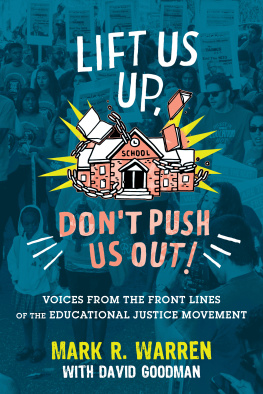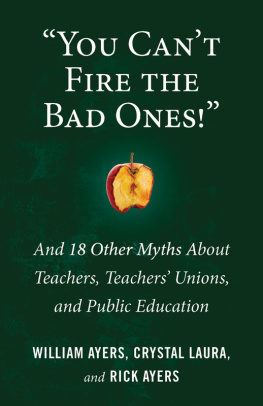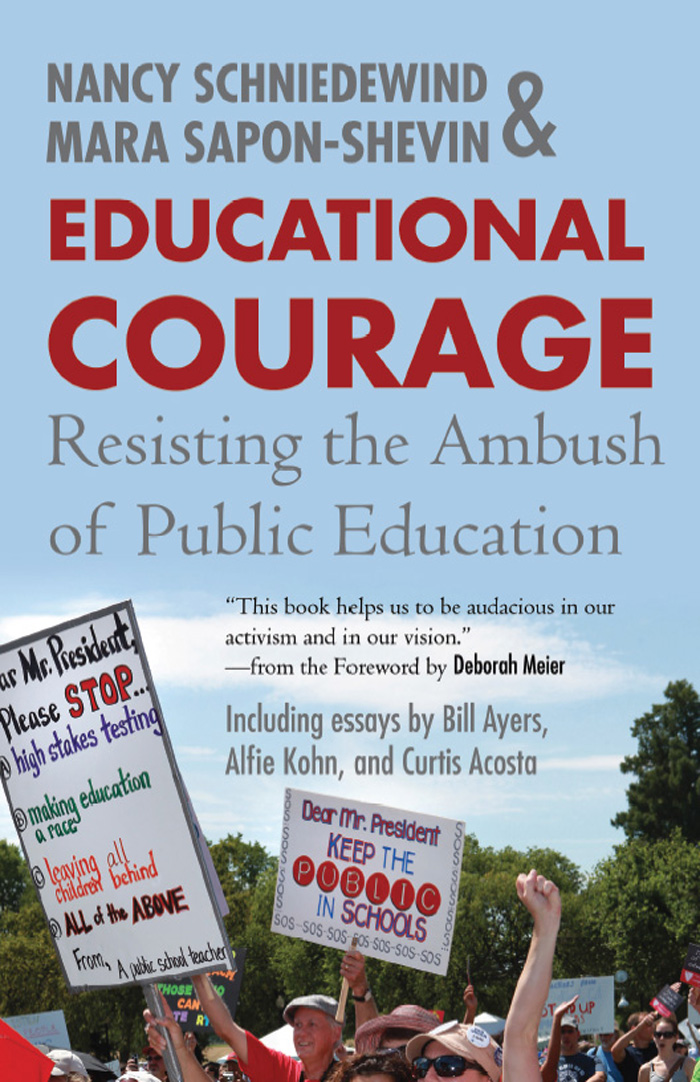Educational Courage
Resisting the Ambush of Public Education
Nancy Schniedewind and Mara Sapon-Shevin
Beacon Press, Boston
Dedicated to the educational courage of all those struggling for more democratic schools and to Julia Grace Schniedewind and Rhoda Myra Ginsberg Sapon
Contents
Deborah Meier
Introduction: Is This What We Call Education?
Nancy Schniedewind
Susan J. Hobart
Wendy J. Goodman
Introduction: I Wont Be a Part of This!Educators, Parents, Students, and Community Members Resist
Kids As Self Advocates (KASA)
Alfie Kohn
Francisco Guajardo
Nate Walker
Doug Christensen and Chris W. Gallagher
Neha Singhal
Latricia Wilson
Curtis Acosta
Introduction: Resisting by Working in the CracksCreating Spaces to Teach Authentically 85
Ellen Davidson
Jessica Klonsky
Felipa Gaudet
Tom Roderick
Introduction: Not My Voice AloneOrganizing to Reclaim Public Education
Sam Coleman and Edwin Mayorga
Katie Hogan
Bob Peterson
Juanita Doyon
Julie Woestehoff
Don Perl
Jane Hirschmann, Ujju Aggarwal, and Donna Nevel
Chris W. Gallagher and Doug Christensen
Kim Dominguez, Bob Peterson, Stephanie Walters, Kathy M. Xiong, Sarah Knopp, Gillian Russom, and Brian Jones
Bill Ayers
Foreword
For thirty years, between 1968 and 1998, I was a part of a surprisingly vigorous educational reform movement that was slowly creeping its way into the mainstream. One part of me recognized that it was unlikely that the largely conservative political climate would be comfortable soil for seeding the kind of liberatory education I envisioned, but another part thrived on a growing consensus on what good schooling might look like. Or so it seemed to me, in that part of the public school establishment I found myself in.
As one of the founders of Central Park East School in New York City, I had the opportunity to work with teachers and students who modeled democracy and valued teacher and student voices. Despite the challenges of creating a school that went against the grain, I had daily victories, those wonderful, precious moments when I could see and enjoy the miracle we had created. Id stop in the hallway and look both ways and feel such a swell of joy that it carried me over the bumps in the road. I listened to the unauditioned chorus with wonder; thats what democracy sounds like, I thought. We had created a community that was sometimes less than ideal but was always a shared cross-generational community. Parents, teachers, other staff, and students knew they were in it together. Progressive educator Lillian Weber insisted on putting her finger on the essential core principle; we needed to create adult communities of learners to tackle the issues facing us together, what we had originally called open corridors. Lillian spoke her mind to power whenever she could and led us to cracks we hadnt dreamed existed, much less dared to test out in practice, and eventually to rebuilding hundreds of schools throughout New York City and beyond.
Today we mourn the loss of some of that work. But what I fear more would be losing the tough-minded understanding of whats needed. While we excitedly chanted the newest slogan, This is what democracy looks like! in Madison, Wisconsin, in the spring of 2011, or in Washington, DC, at the July 2011 Save Our Schools rally, we also realized that we dont want to slip into a simplification. Democracy is not just a rally or even a chorus. The togetherness that democracy depends on, weve learned, is far more complicated than marching or even singing together. Democracy is hardhard to envision sometimesand even harder to achieve. But struggle we must.
The kind of democracy we envision may be utopian, but efforts to create something closer to such an ideal are never fruitless. When Ive been accused of being naive Ive cringed, and yet theres truth to it. Theres a kind of navet we dare not lose. Idealism is not a character flaw; its a way of visualizing what could be and might be.
Schools that do not give us, our families, and our students a chance to experience the complexity of democracyeven down to such details as who should vote, and on whatdeprive children of something they desperately need to learn about. Disagreements that we so carefully try to hide from the young are precisely what the young need to learn about, thoughtfully and mindfully. When we try to hide from children the complexity of creating democratic schoolswhen we make the struggles and the disagreements and the battles invisiblewe deny young people the opportunities to understand how important and challenging this work is. Children learn most efficiently as apprentices to experts, even imperfect experts. Only when we adults accept and model the ways we wrestle with the complex challenges we struggle withas teachers, administrators, and citizenscan our schools become places where children will learn to be responsible adults too.
What do we need now? We desperately need democratic schools. Democracy was invented as a form of accountability. By listening to and valuing every voice, we make it much more likely that we are paying attention to whats really happening and are being responsible to those with whom we interact. And democratic schools are the way to build accountability for education.
And we need resistance to the continuing assault on public education that reduces schools to market-driven factories that select and sort our students, distorting visions of communities of learning and growth and activism. We cant internalize the norm thats out there and cant accept that this is the way things have to be. We mustnt adjust to injustice, losing our visions, our hope, and our active resistance.
One of the most powerful ways to resist the dominant, suffocating narratives that surround usabout whats wrong with schools, about blaming teachers, about the benefits of privatized educationis to create alternative images and share alternative data.
And perhaps the most persuasive forms of alternative data are our stories. Our livesour lived experiencesare our data. Test scores are, at best, indirect evidence of what is happening in schools for children, but our lives and stories are the real data. When we sit down with a child and listen to her read, we have much more useful and powerful evidence of that childs reading skills than through viewing a test score.
This book provides us with real data about what market-driven educational policies have done to our students, our teachers, and our educational system. And the stories here are also the real evidence of what resistance looks like and what is possible when people work individually and collectively to teach in the cracks and to create different realities for children in schools. Corporate-driven educational initiatives undermine teachers judgment and knowledge; they deny the most important source of data that we have, the perceptions and understandings of those closest to the action. While school improvement may be slow, to be effective it must be based on teachers, parents, and students realitytheir own understanding of the lives of children.
This book is all about stories. Stories of pain, stories of hope, stories of possibility, stories of vision, and then, perhaps most significantly, stories of activism and change. Storytelling is an art and its the root of our literacy; this book helps us to become more literate about the world of school and the possibilities of real school change that is rooted in the real lives of children and classrooms. I believe that the stories shared in this book can open our eyes, broaden our perspectives, and engage us in powerful discussions of what is and what still can be.


